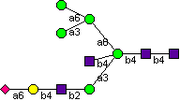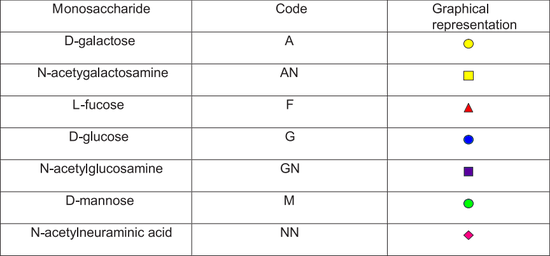Glycan structures
Contents |
Glycan
The terms glycan and polysaccharide are defined by IUPAC as synonyms meaning "compounds consisting of a large number of monosaccharides linked glycosidically".[1] However, in practice the term glycan may also be used to refer to the carbohydrate portion of a glycoconjugate, such as a glycoprotein, glycolipid, or a proteoglycan, even if the carbohydrate is only an oligosaccharide.[2] Glycans usually consist solely of O-glycosidic linkages of monosaccharides. For example, cellulose is a glycan (or, to be more specific, a glucan) composed of β-1,4-linked D-glucose, and chitin is a glycan composed of β-1,4-linked N-acetyl-D-glucosamine. Glycans can be homo- or heteropolymers of monosaccharide residues, and can be linear or branched.
Glycan structures in BioUML
One is able to define glycan structure for chosen species by adding/changing node's attribute "glycanStructure" (or using Antimony). Glycan structures are expressed using acondensed version of IUPAC linear formulas[3] with some minor modifications. The first modification is to order the branches at a branch point based just on the branch locants, without regard to the lengths of the branches. In addition the sugar abbreviations have been replaced with the shorter abbreviations of the LinearCode[4]. Lowercase “a” and “b” denote α and β.[5] After glycan structure attribute set, one is also able to decide if full glycan structure is necessary or not by correspondent flag setting (flag is not set by default). It will affect whether to show captions for edges in visual representation or not. If diagram contains glycan structures, it also has additional flag to hide/show glycans names.
Visual representation
References
- ↑ "IUPAC Gold Book - Glycans"
- ↑ Dwek, Raymond A. (1996). "Glycobiology: Toward Understanding the Function of Sugars". Chem. Rev. 96 (2): 683–720. doi:10.1021/cr940283b. Retrieved 3 October 2013.
- ↑ McNaught AD. 1996. International Union of Pure and Applied Chemistry and International Union of Biochemistry and Molecular Biology – Joint Commission on Biochemical Nomenclature. Nomenclature of carbohydrates –(Recommendations 1996).Pure Appl Chem.68:1919–2008.
- ↑ Banin E, Neuberger Y, Altshuler Y, Halevi A, Inbar O, Nir D, Dukler A. 2002. Anovellinearcode(R)nomenclatureforcomplexcarbohydrates.Trends Glycosci Glycotechnol.14:127–137.
- ↑ Frederick J. Krambeck et al. "A mathematical model to derive N-glycan structures and cellular enzyme activities from mass spectrometric data". Glycobiology (2009) 19 (11): 1163-1175. doi:10.1093/glycob/cwp081


